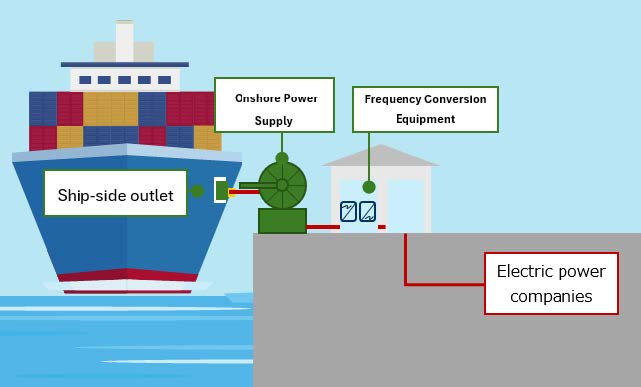TMEIC Receives Order for Japan’s First Onshore Power Supply System with Frequency Conversion Equipment for Public Piers
Promoting the creation of carbon-neutral ports by supplying power to ships from onshore while berthed
TMEIC Corporation (hereinafter, “TMEIC”; President & CEO Akira Kawaguchi; Head Office: Chuo-ku, Tokyo, Japan) has received an order from the Port and Harbor Bureau, City of Yokohama, for an onshore power supply system to be newly installed at Jetty A-4 of the Honmoku Pier in Yokohama. This project will be carried out in collaboration with The Kodensha Co., Ltd. (hereinafter, “Kodensha”; President & CEO Yuji Kajikawa; Head Office: Chuo-ku, Tokyo) and Mitsubishi Electric Corporation (hereinafter, “Mitsubishi Electric”; President & CEO Kei Uruma; Head Office: Chiyoda-ku, Tokyo). This system, which supplies power from land to ships while they are berthed, will be the first of its kind in Japan*1 for public pier use. A frequency conversion device that is included in the system is supplied by TMEIC based on its highly developed power electronics technology.
Greenhouse gas (GHG) emissions from the entire international maritime transport sector, including vessel operations and port facilities, account for approximately 3% of the global total*2. This is said to be equivalent to the emissions of the entire country of Germany. The International Maritime Organization (IMO) has set a target of achieving zero GHG emissions by around 2050 and is advancing efforts to realize carbon-neutral ports worldwide.
Traditionally, ships berthed at ports have relied on onboard generators to supply the power needed for lighting, air conditioning and other systems. The onshore power supply system that TMEIC has recently been contracted to provide will contribute to the reduction of GHG emissions, including carbon dioxide, and air pollutants such as sulfur oxides and nitrogen oxides, emitted from ships by supplying power from the shore to the vessels while they are berthed. GHG emissions from ships while berthed constitute approximately 38% of the emissions from the coastal transportation sector. Therefore, halting the idling of ships while berthed is believed to have a significant impact on reducing GHG emissions.
Furthermore, while ships typically operate their generators at a frequency of 60Hz, the East Japan region, including the City of Yokohama, operates on a 50Hz power supply. Therefore, converting the frequency to 60Hz for berthed ships is necessary. To address this requirement, the system incorporates frequency conversion equipment produced by TMEIC together with transformer and substation infrastructure delivered by the two collaborative entities. This conversion process ensures that the 50Hz power supplied to onshore facilities in the East Japan region is converted to the 60Hz power required by ships while they are berthed. By doing so, the system ensures power quality
compliant with both the harmonic suppression guidelines*3 set by the Ministry of International Trade and Industry (now the Ministry of Economy, Trade and Industry) in 1994 and the international standard IEC 80005.
Going forward, Kodensha, Mitsubishi Electric and TMEIC will collaborate to advance construction work efficiently toward an early completion, contributing to the creation of carbon-neutral ports promoted by the Port and Harbor Bureau, City of Yokohama.
Drawing on our extensive business experience in port areas, TMEIC has been expanding its product range to contribute to the advancement of port functions aligned with decarbonization efforts, while also providing global solutions such as crane control automation and yard management. Moving forward, the Company will further grow its lineup of frequency conversion devices for onshore power supply systems, tailored to the power supply capacity of various ports, and in turn, aim to support the realization of carbon-neutral ports both in Japan and around the world.

*1 As of January 22, 2024, according to Mitsubishi Electric research
*2 Source: IMO’s “Fourth Greenhouse Gas Study 2020”
https://www.imo.org/en/OurWork/Environment/Pages/Fourth-IMO-Greenhouse-Gas-Study-2020.aspx
*3 Summarizes guidelines and methods for suppressing the generation and propagation of harmonics in electronic equipment and communication systems
